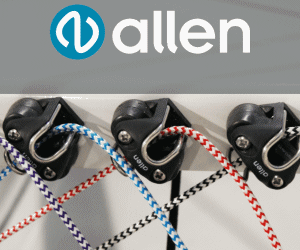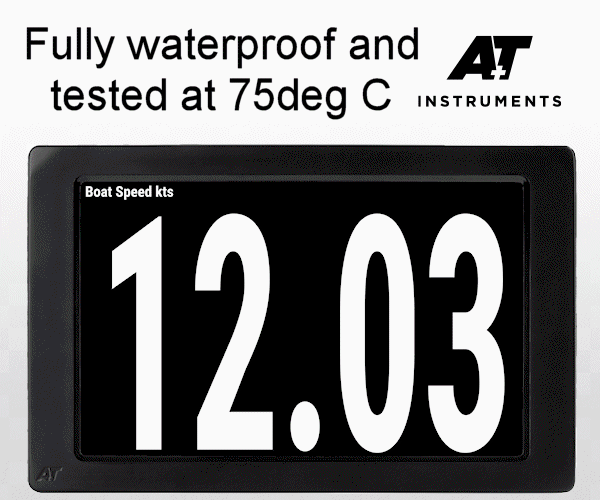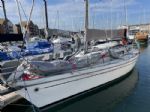












| Laser 140101 Tynemouth |
 |
| Rossiter Pintail Mortagne sur Gironde, near Bordeaux |
 |
| Laser 28 - Excellent example of this great design Hamble le rice |
 |
List classes of boat for sale |
Asymetric Gybe |
Post Reply 
|
Page 12> |
| Author | |
feva sailor 
Posting king 
Joined: 03 Sep 08 Location: United Kingdom Online Status: Offline Posts: 186 |
 Post Options Post Options
 Quote Quote  Reply Reply
 Topic: Asymetric Gybe Topic: Asymetric GybePosted: 03 Sep 08 at 9:39pm |
|
okay this is my heavy wind gybe step by step in my FEVA 1. make sure the crew is aware of the gybe!! (im crew and can tell you how anoying it is if the helm lost his voice!!!) 2. let the kicker off (depower sail) 3. come on to a run. 3. start gybe, use the strop (if you have one) to whip the boom over ASAP 4. move back onto the run before you overpower.(make sure you dont over steer and gybe again or depower so much it comes on top of you) reaply kicker and when crew is ready bear back up so the jenny fills Edited by feva sailor |
|
 |
|
redback 
Really should get out more 

Joined: 16 Mar 04 Location: Tunbridge Wells Online Status: Offline Posts: 1502 |
 Post Options Post Options
 Quote Quote  Reply Reply
 Posted: 02 Sep 08 at 9:56pm Posted: 02 Sep 08 at 9:56pm |
|
It sounds like a waste of speed to me - but I'll try it. My experience is to get the gybe in before the boat loses speed then sort out the kite. As for the jib, have knots to stop it going to far forward and just leave it uncleated - its a distraction. You'll notice the big boats and even the Yingling drop the jib when the kite is up. As for steering remember you are going fast and so should be gentle. You'd steer a car gently at high speed wouldn't you - its completely analogous. I can tell you that when you're doing nearly 20Knots (which I think the 4000 does) the steering is knife edge you have to be so very careful. |
|
 |
|
NickA 
Really should get out more 
Joined: 30 Mar 05 Location: United Kingdom Online Status: Offline Posts: 784 |
 Post Options Post Options
 Quote Quote  Reply Reply
 Posted: 02 Sep 08 at 5:11pm Posted: 02 Sep 08 at 5:11pm |
|
Anyone else pre-gybe the kite? I've learnt it as a help for single handing but found it helps when double handing too
Some musto skiff bloke recommended it to me. Feels nice when it works! |
|
|
Javelin 558
Contender 2574 |
|
 |
|
ellistine 
Really should get out more 
Joined: 06 Mar 08 Online Status: Offline Posts: 762 |
 Post Options Post Options
 Quote Quote  Reply Reply
 Posted: 29 Aug 08 at 11:43am Posted: 29 Aug 08 at 11:43am |
|
I tried most of the suggestions on Tuesday night and had quite a laugh. 4 capsizes but interestingly all when turning to the right. The ones to the left all felt quite good though. It was quite exciting (and a little nerve racking) waiting until we were really steaming before thowing it into a gybe. Would never have done that before! I just need to sort out my right turns. I think my steering isn't constant enough turning right which puts the boat into a bit of a wobble and then a capsize. I had quite a few turns which I aborted as the boom wasn't coming across and again I think these were all right hand turns. My aim now is to turn a bit tighter, keep the arc constant, get the boom across and get out and hiking. I'm actually now less concerned about what's going on with the kite as it seems to be the steering that causes most of the problems. Still, practice, practice, practice! Edited by ellistine |
|
 |
|
redback 
Really should get out more 

Joined: 16 Mar 04 Location: Tunbridge Wells Online Status: Offline Posts: 1502 |
 Post Options Post Options
 Quote Quote  Reply Reply
 Posted: 25 Aug 08 at 11:16pm Posted: 25 Aug 08 at 11:16pm |
|
Definitely when going down a wave but well before the bow goes into the back of the next one. Basically its the same advice - when going fast. As for the wobble, try pulling the main in - its surprising how far it can come in and still maintain airflow across it, and being lengthwise in the boat it damps out the wobble. I've not sailed a 200 - I'm a bit big at 13½ stone but I have sailed the 400. It could be you're bringing the board up too much too. I know the 4000 is not that comparable but we have the board down all the time - that's fully down, upwind and down. Mainly because we never get a chance to pull it up. We don't "trip over it" as the books suggest because we don't throw the boat through a gybe. We steer a nice radiused curve with the boat flat and its no problem. Again with the main we sometimes have it nearly as tight as beating, but then again we don't soak as deep as a 200. Still I'm sure if you bring it in a bit you'll give yourself more time to correct the sudden loss of heeling from the kite. Then from my Laser sailing days I remember its good to ease the kicker but not too much because if you do the top of the leach is no longer able to help dampen the wobble. And from my Scorpion days I remember that the further back you sit the more stable the hull is, perhaps that will help. |
|
 |
|
pondscum 
Groupie 

Joined: 06 Nov 07 Location: United Kingdom Online Status: Offline Posts: 99 |
 Post Options Post Options
 Quote Quote  Reply Reply
 Posted: 25 Aug 08 at 10:40pm Posted: 25 Aug 08 at 10:40pm |
|
Very appropriate topic for us pond muppets at the 200 nationals today - we wimped out at Chichester bar when the waves got bigger than the day before (but did then scream back in all on one tack with the kite up
         ). Then proceeded to break every one of the bits of advice about gybing here whilst messing about in the harbour (along with the advice about keeping to the marked channels, the Solo over there is the other side of a sand bank...). ). Then proceeded to break every one of the bits of advice about gybing here whilst messing about in the harbour (along with the advice about keeping to the marked channels, the Solo over there is the other side of a sand bank...).My supplementary question - what is the correct point on a wave to gybe? Also any hints on surfing with the kite up - went in on Sunday twice with the kite up following being 'pooped' I guess by a wave hitting the stern and pushing us down wind - kite collapses, boat goes into wobble, sometimes my heroic ballast catches it, sometimes I fluff the stick waggling. Should I be pointing higher even though I can/want to soak downwind? |
|
 |
|
redback 
Really should get out more 

Joined: 16 Mar 04 Location: Tunbridge Wells Online Status: Offline Posts: 1502 |
 Post Options Post Options
 Quote Quote  Reply Reply
 Posted: 25 Aug 08 at 6:57pm Posted: 25 Aug 08 at 6:57pm |
|
Some good advice from several people above. Here's what I have found. Keep the power on so that you have speed (ie don't let the crew come into the centre line in preparation). Turn very gently - make a big radius - several boat lengths. Don't gybe through 90 degrees but gybe to just past a run. So if your doing 45 degress to the wind you'll turn through 60 - this will require a little correction on the helm to stop the boat rounding up to a reach. You don't need to let the main out much at all - best if its in it will help damp out any rocking, and give it a little tug when you want it to go across. Once the crew has settled and got the correct sheet in his hand you can head up and this will encourage him to move his weight out. As you get more experienced you'll synchronise and be able to round up after the gybe ealier. My crew is a very experienced Laser helm and when she helmed our 4000 in a blow the first thing she tried to do was gybe inside someone at a mark. A definite mistake, because you are going so fast you have to turn very gently and this takes up space. But because you are going so fast the pressure goes off the rig when you turn downwind and the gybe is easy and then you gradually load the power back on once the crew is in place by turning upwind to your new course. Novices always seem to gybe straight onto the next course and get over powered. Try and separate the gybe from a mark rounding, so gybe when you're going fast - get the gybe out of the way and then work out where you're going to point. When its really blowing the crew gets nervous and tends to come in early - that is a disaster because then the boat is going slow and there's lots of pressure in the rig. If they do come in early or you slow down for some other reason don't attempt a gybe - head back up a bit and get flying. The more you "go for it" the more successful you are going to be but you still have to be very gentle on the helm. |
|
 |
|
ellistine 
Really should get out more 
Joined: 06 Mar 08 Online Status: Offline Posts: 762 |
 Post Options Post Options
 Quote Quote  Reply Reply
 Posted: 23 Aug 08 at 12:44pm Posted: 23 Aug 08 at 12:44pm |
Still struggling a bit with this one to be honest. I'm working more on knowing how to not let go!
|
|
 |
|
Contender 541 
Really should get out more 

Joined: 05 Dec 05 Location: Burton on Trent Online Status: Offline Posts: 1402 |
 Post Options Post Options
 Quote Quote  Reply Reply
 Posted: 23 Aug 08 at 12:01pm Posted: 23 Aug 08 at 12:01pm |
|
3 things to keep in mind Communication - Moveable balast needs to know what the stick monkey is about to do Bravery - Gybe at speed (do not confuse this with gybe quickly) Synchronicity - An off shoot of communication, but moving across the boat together is a good idea
Know how to swim |
|
|
When you find a big kettle of crazy it's probably best not to stir it - Pointy Haired Boss
Crew on 505 8780 |
|
 |
|
dopamine 
Groupie 
Joined: 26 Oct 06 Location: Burkina Faso Online Status: Offline Posts: 68 |
 Post Options Post Options
 Quote Quote  Reply Reply
 Posted: 23 Aug 08 at 7:54am Posted: 23 Aug 08 at 7:54am |
|
As someone who's gybes vary from sublime to catastrophic I would add:
Try to sheet the main in slightly to bring the falls closer to you and therefore easier to grab, this will also contribute to keeping speed on. We try to actually pump a bit of extra speed out of the boat before gybing and when it works it is so sweet! Confidence (or fearlessness) is the key. |
|
 |
|
Post Reply 
|
Page 12> |
| Forum Jump | Forum Permissions  You cannot post new topics in this forum You cannot reply to topics in this forum You cannot delete your posts in this forum You cannot edit your posts in this forum You cannot create polls in this forum You cannot vote in polls in this forum |
Copyright ©2001-2010 Web Wiz
Change your personal settings, or read our privacy policy












 Printable Version
Printable Version Delicious
Delicious Digg
Digg Facebook
Facebook Furl
Furl Google
Google MySpace
MySpace Newsvine
Newsvine reddit
reddit StumbleUpon
StumbleUpon Twitter
Twitter Windows Live
Windows Live Yahoo Bookmarks
Yahoo Bookmarks Topic Options
Topic Options